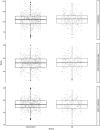IQ After Pediatric Concussion
- PMID: 37455662
- PMCID: PMC10389777
- DOI: 10.1542/peds.2022-060515
IQ After Pediatric Concussion
Abstract
Objectives: This study investigated IQ scores in pediatric concussion (ie, mild traumatic brain injury) versus orthopedic injury.
Methods: Children (N = 866; aged 8-16.99 years) were recruited for 2 prospective cohort studies from emergency departments at children's hospitals (2 sites in the United States and 5 in Canada) ≤48 hours after sustaining a concussion or orthopedic injury. They completed IQ and performance validity testing postacutely (3-18 days postinjury; United States) or 3 months postinjury (Canada). Group differences in IQ scores were examined using 3 complementary statistical approaches (linear modeling, Bayesian, and multigroup factor analysis) in children performing above cutoffs on validity testing.
Results: Linear models showed small group differences in full-scale IQ (d [95% confidence interval] = 0.13 [0.00-0.26]) and matrix reasoning (0.16 [0.03-0.30]), but not in vocabulary scores. IQ scores were not related to previous concussion, acute clinical features, injury mechanism, a validated clinical risk score, pre- or postinjury symptom ratings, litigation, or symptomatic status at 1 month postinjury. Bayesian models provided moderate to very strong evidence against group differences in IQ scores (Bayes factor 0.02-0.23). Multigroup factor analysis further demonstrated strict measurement invariance, indicating group equivalence in factor structure of the IQ test and latent variable means.
Conclusions: Across multisite, prospective study cohorts, 3 complementary statistical models provided no evidence of clinically meaningful differences in IQ scores after pediatric concussion. Instead, overall results provided strong evidence against reduced intelligence in the first few weeks to months after pediatric concussion.
Copyright © 2023 by the American Academy of Pediatrics.
Conflict of interest statement
Figures



Comment in
-
IQ After Pediatric Concussion: Clinical Considerations.Pediatrics. 2023 Aug 1;152(2):e2023062182. doi: 10.1542/peds.2023-062182. Pediatrics. 2023. PMID: 37455663 Free PMC article. No abstract available.
References
-
- Nguyen R, Fiest KM, McChesney J, et al. . The international incidence of traumatic brain injury: a systematic review and meta-analysis. Can J of Neurol Sci. 2016;43(6):774–785 - PubMed
-
- Anderson V, Catroppa C, Morse S, Haritou F, Rosenfeld J. Functional plasticity or vulnerability after early brain injury? Pediatrics. 2005;116(6):1374–1382 - PubMed
-
- Ewing-Cobbs L, Barnes MA, Fletcher JM. Early brain injury in children: development and reorganization of cognitive function. Dev Neuropsychol. 2003;24(2-3):669–704 - PubMed
-
- Jaffe KM, Polissar NL, Fay GC, Liao S. Recovery trends over three years following pediatric traumatic brain injury. Arch Phys Med Rehabil. 1995;76(1):17–26 - PubMed
Publication types
MeSH terms
Grants and funding
LinkOut - more resources
Full Text Sources
Medical

